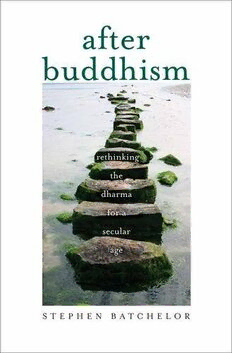
After Buddhism: Rethinking the Dharma for a Secular Age PDF
Preview After Buddhism: Rethinking the Dharma for a Secular Age
After Buddhism AFTER BUDDHISM rethinking the dharma for a secular age Stephen Batchelor Published with assistance from the foundation established in mem- ory of Philip Hamilton McMillan of the Class of 1894, Yale College. Copyright © 2015 by Stephen Batchelor. All rights reserved. This book may not be reproduced, in whole or in part, including illustrations, in any form (beyond that copying permitted by Sections 107 and 108 of the U.S. Copyright Law and except by reviewers for the public press), without written permis- sion from the publishers. Yale University Press books may be purchased in quantity for educational, business, or promotional use. For information, please e-mail [email protected] (U.S. office) or [email protected] (U.K. office). Map by Bill Nelson. Designed by Mary Valencia. Set in Scala type by Integrated Publishing Solutions. Printed in the United States of America. Library of Congress Control Number: 2015935009 ISBN 978-0-300-20518-3 (cloth : alk. paper) A catalogue record for this book is available from the British Library. This paper meets the requirements of ANSI/NISO Z39.48–1992 (Permanence of Paper). 10 9 8 7 6 5 4 3 2 1 For Don Cupitt The dharma is clearly visible, immediate, inviting, uplifting, to be personally sensed by the wise. —Gotama, the Buddha (c. 480–c. 400 bce) The dharma of the buddhas has no special undertakings. Just act ordinarily, without trying to do anything in particular. Move your bowels, piss, get dressed, eat your rice, and if you get tired, lie down. —Linji Yixuan (d. 866) Contents Preface ix 1. After Buddhism 1 2. Maha¯na¯ma: The Convert 29 3. A Fourfold Task 54 4. Pasenadi: The King 90 5. Letting Go of Truth 115 6. Sunakkhatta: The Traitor 151 7. Experience 178 8. J¯ivaka: The Doctor 206 9. The Everyday Sublime 231 10. A¯nanda: The Attendant 260 11. A Culture of Awakening 293 Afterword 323 Selected Discourses from the Pali Canon 333 Notes 343 Bibliography 365 Index 373 This page intentionally left blank Preface This book is an attempt to synthesize an understanding of Buddhism that I have been working toward since my first publication, Alone with Others, appeared in 1983. In the intervening thirty years I have pub- lished a number of other writings that have branched off in different directions but maintained, at least in the eyes of the author, a steady focus on a single question: What does it mean to practice the dharma of the Buddha in the context of modernity? My most recent publica- tion, the essay “A Secular Buddhism” (2012), can be seen as a prepara- tory sketch of what I seek to flesh out in this book. I am indebted to Geshe Tamdrin Rabten for training me in Ti- betan Buddhist logic, epistemology, and philosophy, which provided the intellectual foundations for everything I have done since; Satya Narayan Goenka for introducing me to the practice of vipassana¯ and the early Buddhism of the Pali Canon; and Kusan Sunim for instruct- ing me in the practice of Korean So˘n (Zen), which, together with mind- ful awareness, continues as the basis for my practice of meditation. While all of these Buddhist traditions have played an important role in my understanding and practice of the dharma, my interpretations of cer- tain Buddhist doctrines may strike some readers as highly unorthodox. My primary authority for understanding what the Buddha taught is the discourses of the Pali Canon. My inability to read Chinese is ix
